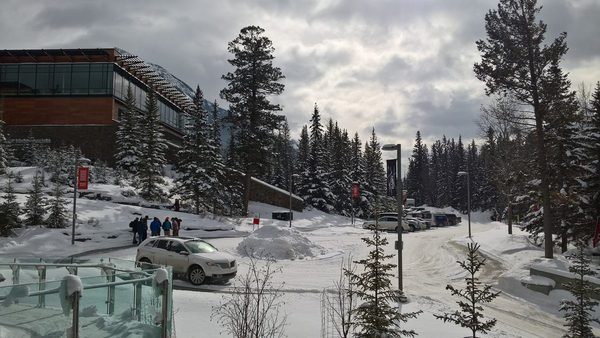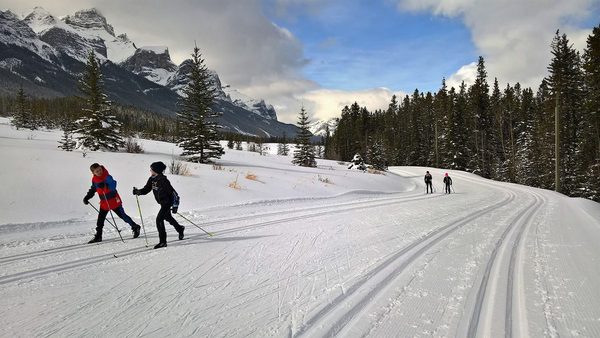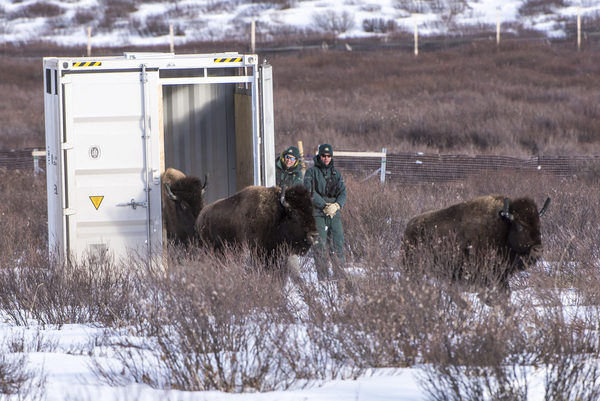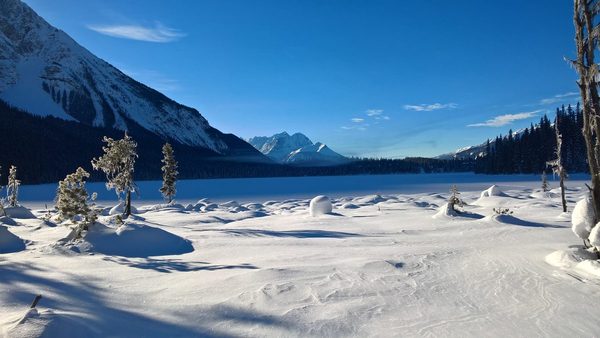
PearlAnn Reichwein and Michelle Murphy
“Is there anyone among us who has the courage to stand and say, will tomorrow’s child know the wonders I see today?”
Wonders I’ve Seen by The Bills (2016)
This year the Canadian Parks Conference 2017 was held in Banff National Park at the Banff Centre, overlooking Banff town and the Bow Valley from March 8-11.
Hosted by the Alberta Recreation and Parks Association with its partners the Canadian Recreation and Parks Association, and the Canadian Parks Council, the conference, which included many invited speakers and three hundred attendees, was an inspired four days of discussion. As Edmonton members, we volunteered to represent Sierra Club Canada Foundation at the event.
Photo (above right): Mount Rundle in morning light, seen from the Banff Centre. Photo: PearlAnn Reichwein.
Bison Belong project. Photo: Johane Janelle
View of Banff and Bow Valley from conference at Banff Centre. Photo: Michelle Murphy.
The conference was an open invitation to dialogue with more stakeholders and share challenges. It featured six keynote talks and a hundred speakers in more than 45 breakout sessions. Building on last year’s Canadian Parks Summit, a meeting of leading experts and delegates in Canmore, Alberta, the work is now in progress for a draft “Parks for All” national strategic framework.
The central question that the conference addressed was what role do parks and protected areas play in biodiversity, conservation, and health? The answer is an invaluable role because they interconnect larger networks of life. A strong call was issued for collaborative participation in work across Canada by cities, regions, and Indigenous nations. Parks and protected areas of all kinds and jurisdictions have a role to play in our living world – a world which seen from outer space is a world without borders.
Dawn Carr, Executive Director of the Canadian Parks Council, welcomed all collaborators, stating: “Our common ground…is rooted in understanding that Earth and our healthy relationship to it is all we really have in common.”
We Are the Land and Indigenous Protected Areas
Elder Dave Courchene, Jr. of the Sagkeeng First Nation of Manitoba and founder of Turtle Lodge, opened as keynote speaker with a talk about relations on “our sacred earth.” He pointed out special relationships between animals and nurturing the spirit. “True guardianship is aligned with nature, speaking and listening to what she has to say," noting that the land and society has changed, but a clear role remains “to protect the intimate relationship with the land and all life’s dependents on it.”
Courchene called for a new inclusive paradigm of Indigenous leadership on the land. “Land guardianship is the fundamental issue. It is the only foundation from which we can build a future for all of our children.” He called for thought and heart going forward in an acceptance of “true guardianship” as part of reconciliation with Indigenous peoples. “We have much to share with you as partners.”

Blackfoot drummers and champion powwow dancers perform on opening night of conference. Photo: PearlAnn Reichwein
Drum and song of the four great nations of the Blackfoot Confederacy or Siksikaitsitapi filled the room Wednesday night as champion powwow dancers performed, culminating in a friendship dance with delegates who had come from many parts of Canada.
Indigenous protected areas and management were a key topic of discussion throughout the conference. Dave Porter, a former Yukon minister, called for a governance paradigm shift to a national Indigenous Guardian Program as a new way forward in the area of conservation – a program that was later included in the federal Budget released last week. Members of the Haida Watchmen also attended and presented examples of their co-management approach to the conservation of territories in British Columbia.
Conservation and Biodiversity: What part will parks and protected areas play?
Dr. Jeff Wells and Dr. Stephen Woodley highlighted the global biodiversity crisis and urged the delegates and Canadians in general to rethink conservation. Dr. Wells, who is with the Boreal Songbird Initiative, called parks the “lifeblood of biodiversity.” He pointed out that the boreal forest contains 25 percent of Earth’s remaining intact forest and supports some of the last great migrations – and 85 percent of this habitat is in Canada, so we can play a key role in protecting it.
Dr. Wells highlighted the Cape May Warbler, a bird species with 80 percent of its population living in the boreal forest. By dusting its face inside flowers, the little bird is believed to be a pollinator when it migrates south for winter.
However, with less than 15 percent of the Boreal Forest under permanent protection, the forest is threatened. Degradation of the forest has caused the loss of large mammals and decreased bird populations. Combined with climate change, this will force species further north. Dr. Wells urges us to re-think conservation in Canada and especially the role parks have to play here.

Conference delegates enjoy fresh snow at Banff Centre. Photo: PearlAnn Reichwein.
As senior advisor of Biodiversity and Climate Change for the International Union for Conservation of Nature (IUCN), Dr. Stephen Woodley called for a reimagining of conservation by halting biodiversity loss through a collective vision. He asked the question: how do we feed and provide for a growing population in the Anthropocene while still maintaining biodiversity and planetary life?
Dr. Woodley emphasized the importance of protected areas in ensuring biodiversity. Canada’s current protected areas are not sufficient, well-designed, well-managed, or integrated enough to ensure the conservation of nature. He reminded us that the biodiversity crisis of late-19th-century extinctions was brought under control through conservation, and with new conservation efforts, we can do it again. With Sierra Club about to celebrate its own 125th anniversary on May 28, his reminder of such history of nature advocacy resonated powerfully for us as members.
Connecting people to nature is important. However, conserving nature should be a top priority for Canada’s Protected Areas Network. A strong biodiversity statement is key for the upcoming “Parks for All” document Woodley advised the conference, succinctly reminding us that it is the role of the Lorax to “speak for the trees.”
Healing with Time on the Land and a Prescription for Outdoor Play
Olympian Clara Hughes celebrated nature’s healing powers in her passionate story of time spent on the land. As adventurers, she and her husband were inspired by the teachings of the Haida Watchmen and elders in Haida Gwaii as they paddled and travelled the archipelago on the Pacific coast of British Columbia. They were touched by the love of the land shown by the Lutsel K’e Dene First Nation in Thaidene Nene, which is a proposed National Park Reserve on the northern edge of the boreal forest in the Northwest Territories. Working with Indigenous communities can allow us to “reach all kinds of conservation goals,” she said. “Time on the land” can also promote mental health and healing, a particular consideration for Indigenous youth and suicide prevention.

Outdoor life at Canmore Nordic Centre Provincial Park, visited by conference goers. Photo: PearlAnn Reichwein
As a physiologist in public health, Dr. Mark Tremblay was an atypical delegate but provided a strong message. He sees parks as the most powerful force in the promotion of health and wellbeing especially in an age where instead of playing tag outside, kids are using hashtags inside; and 91 percent are not meeting the minimum recommended activity levels.
This needs to change and parents are encouraged to see too much time spent indoors as a health risk and refocus children on daily free play outdoors. Dr. Tremblay believes parks and public health need each other. We need to work cooperatively to promote conservation and health congruently. A joint national statement for “active outdoor play in nature and outdoors” signed by diverse stakeholders, including ParticipACTION, is one example. Sierra Club Canada Foundation’s Wild Child programs in Nova Scotia and Prince Edward Island are another such collaborative effort to connect children’s play with the natural world.
Federal and Provincial Ministers Speak for Conservation and Parks
The Minister of Environment and Climate Change, the Hon. Catherine McKenna spoke to the conference at a lunch plenary. She radiated “bison fever” after a morning visit to see wild buffalo in the Panther Valley and talk with Canadian Rockies School children excited by the new Bison Belong wildlife project. The Minister indicated a renewed focus on national park ecological integrity and a move forward on Reconciliation, including development of Indigenous protected areas. With reference to international targets for biodiversity, she said: “Canada will make progress on Aichi.”

Bison return to Banff National Park on February 1, 2017. Photo: Bison Belong.
McKenna also indicated Parks Canada has a plan to manage free national parks visits in 2017, a particular concern for the much visited mountain parks. Less was said of major infrastructure proposals, such as the Icefields Trail (North) planned for Jasper that is currently under public consultation, and controversial development issues such as hotels, ski hills, and skywalks, or enlargement of RV campsites, in national parks, but she said they were listening after recent feedback. McKenna also shared her own special nature moments spent with her children walking tidal beaches of Haida Gwaii and tracking wildlife in Banff National Park. She concluded by saying that more protected natural spaces are the best way to mark Canada’s 150th year.
After her speech, McKenna took time to greet SCCF Edmonton volunteers and CPAWS members in the crowd as well as ask students about park research work at University of Alberta.

Minister McKenna greets SCCF volunteers Michelle Murphy and Dr. PearlAnn Reichwein (right), and researcher Chelsea Parent (left). Parent and Murphy are graduate students in the U of A’s Faculty of Physical Education and Recreation. Photo: Alison Woodley.
Alberta Minister of Environment and Parks Shannon Philips also spoke at the conference. She emphasized new measures proposed under Premier Notley to protect the Castle-Crown region of Alberta’s eastern slopes. A push for further changes during public consultation is being undertaken by Alberta Wilderness Association and others concerned by unfettered vehicle use and other incursions.
Philips also detailed upcoming capital investment of $240 million in provincial parks and tourism as Alberta diversifies its economy. Deferred maintenance under past governments will be addressed by capital spending on park and campground facility upgrades for efficiency and inclusive access. She also revealed work underway for a new UNESCO World Heritage Site at Writing on Stone Provincial Park. Minister Philips also embraced integrating Indigenous leadership and park management. “I’d have to be given a very good reason why any parks initiative would not involve Indigenous co-management,” said Philips to applause. “When we know better, we do better.”
Parks are part of physical wellbeing, health, and an insurance policy in face of climate change indicated the Minister, who also heads Alberta’s climate change office. She observed that following major disasters the “value of having natural safeguards has never been more urgent to Albertans.”
A Role for Cities and Regions
Ecosystems services of parks and protected areas are equally vital at the local level of cities and regions. Conservation projects presented at the conference ranged from models for new green levies led by SNAP/CPAWS in greater Montreal, to Edmonton’s Breathe green network strategy, to educational programs for a fiftieth anniversary celebration of the larger Vancouver Regional Parks system this year. Cities and regions are finding common ground for parks and protected areas across the country – and it’s green. Further, the new federal budget for 2017 made provision for green infrastructure in the years ahead, including $5 billion for green infrastructure funding over the next five years, some of which will support green spaces and the work they do to reduce impacts of climate change and contribute to water management, conservation, and protection.
As a non-government organization, Sierra Club Canada Foundation’s local grassroots efforts have involved collaborations in Edmonton to retain primary animal habitat with use of wildlife corridors and underpasses, incorporated into Municipal and Ecological Reserve lands, as new suburbs are built. Ongoing efforts also emphasize the importance of “low impact development” best practice in the urban drainage system. Fish and habitat conservation have also highlighted the need for the Precautionary Principle and stronger environmental impact assessments.
Cities can get onboard as key partners for collaborative and pro-active ecological protection as a way forward.
Shared ideas can cross-pollinate and research can inform a generational shift allowing cities and regions to build and expand conservation networks and civic support for conservation in collaboration with multilateral partners.
Notably, the idea of parks as a city’s “green lungs” and an antidote to urban ills dates back to social reform and conservation movements in the 19th century. Modern urbanization and growth in Canadian cities were intensive. Significantly, conservation and health practitioners often did band together with local community leaders to promote ways of dealing with significant challenges such as wildlife extinction, polluted water, and high infant mortality rates – and their efforts led society to reset the bar for the public good. The early Canadian Commission of Conservation (1909-1921) was a shining example of such broad thinking and scientific engagement. Moreover, urban parks, playgrounds, and various other social service outreaches to diverse families and newcomers were the very origins of public recreation in cities like Winnipeg and Chicago.
Once again, the Canadian Parks Conference 2017 is making attempts to shift the conversation needed for integrated interaction and forward traction for ecosystems and health as shared public benefits. The “Parks for All” draft document, discussed in workshops at the conference, is an attempt to formulate a national strategic framework. It is an ambitious attempt that is still a work in progress, but needed to achieve concerted efforts across cities, regions, and nations. We all have a role to play.
The Bigger Picture of Home: Time for Change
Overall, the Canadian Parks Conference highlighted the importance of parks and protected area and that a coordinated approach was needed in the areas of conservation, reconciliation, and health. Emphasis was on fundamental need for biodiversity, ecosystem services, and social equity. And these objectives will be met by interconnecting initiatives as building blocks on a landscape scale. Nearby wild lands and regional parks, like Victoria Capital Region Parks as one example, have a key role in raising public awareness of the importance of nature and outdoor experiences and this will in turn promote biodiversity as part of a larger system.
Nonetheless, warnings in a recent UNESCO report with recommendations for Wood Buffalo National Park World Heritage Site underscore the complex challenges faced on a vast landscape scale. The impact of current and proposed resource extraction (e.g. forestry, hydro dams, oil sands) and other factors (e.g. invasive species, climate change) extend from British Columbia to Alberta and beyond. These challenges are not easily met and also have impacts on Indigenous territories. It was for this reason First Nations urged UNESCO to make its assessment.
Parks and protected areas are also a civic space where ecological lessons can be learned and outdoor social experiences shared. This will mean that biodiversity targets are met and cross-cultural understanding is improved. In this regard, new graduate research taking place in Alberta provincial parks is focused on social science topics as diverse as human mortality and grief, refugee experiences, and food harvesting, and points to the important role of nature and community in healing.
Parks Canada’s ambitious Bison Belong project which involved moving bison from the open nursery of Elk Island National Park to Banff National Park is an example of a large scale project. But species survival and community wellbeing are ensured by linking large scale projects with local initiatives.
James Bernard Harkin (1875-1955), Canada’s first Commissioner of National Parks, believed that “National Parks are maintained for all the people...” as a living and inspired place:
"They exist in order that every Citizen of Canada may satisfy his craving for Nature and Nature’s beauty; that he may absorb the poise and restfulness of the forests; that he may steep his soul in the brilliance of the wild flowers and the sublimity of the mountain peaks; that he may develop in himself the buoyancy, the joy and the activity he sees in the wild animals; that he may stock his mind with the raw material of intelligent optimism, great thoughts, noble ideals; that he may be made better, happier, and healthier."
But such inspiration requires a living place and making the environment a first priority.

Morning at Emerald Lake in Yoho National Park, Photo Credit: PearlAnn Reichwein
Similarly Sierra Club’s founder John Muir (1839-1914) advocated for leadership to establish parks and protected areas. In 1912 he wrote: “Everybody needs beauty as well as bread, places to play in and pray in, where nature may heal and give strength to body and soul alike.” He also saw bigger picture connections and commonalities of life in places like Yosemite National Park:
"How hard to realize that every camp of men or beast has this glorious starry firmament for a roof! In such places standing alone on the mountain-top it is easy to realize that whatever special nests we make - leaves and moss like the marmots and birds, or tents or piled stone - we all dwell in a house of one room - the world with the firmament for its roof - and are sailing the celestial spaces without leaving any track."
Dwelling in a shared house is what “Parks for All” can really mean. And a shared home means shared work of mind and heart bringing many hands together.
We imagine Harkin and Muir would have been right at home, as were we all, at the Canadian Parks Conference 2017. We encourage Canadians to play a leadership role to create more parks and protected natural spaces and ecological networks as part of Canada’s 150th legacy. We at Sierra Club Canada Foundation look forward to collaborating in this process.
PearlAnn Reichwein is a historian and associate professor at University of Alberta in the Faculty of Physical Education and Recreation. Author of the award-winning book, Climber’s Paradise: Making Canada’s Mountain Parks, 1906-1974, she specializes in park history and mountain studies. She volunteers locally for Sierra Club Canada and North Saskatchewan River Valley Conservation Society in Edmonton; she also served as a Prairie member on SCCF’s national board.
Michelle Murphy is an MA student in Recreation and Leisure Studies at University of Alberta. A former advisor at MacEwan University in Edmonton, she has an avid interest in the benefits of relationships with horses and dogs, particularly in urban and rural Alberta parks. She volunteers for parks and protected areas with Edmonton’s local Sierra Club Canada.
The authors gratefully acknowledge Edmonton's SCCF for its contribution to conference travel funding.
